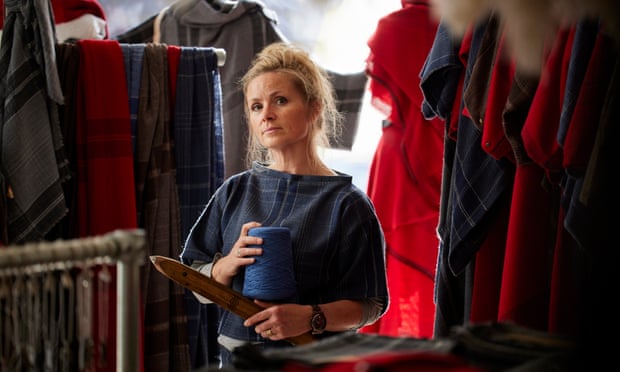Visits: 29
Hi-tech softening enzymes offer hope of revival for Scottish wool industry
Research project hopes to help coarser fleece from hill-farmed flocks compete with imported merino and cashmere

In a laboratory in Edinburgh, carefully selected enzymes are right now breaking down a sheep’s fleece in the name of science.
In a world-first research project that advocates for native textiles believe could catalyse a revival of the Scottish wool industry, researchers are exploring ways to treat the coarser fleece that is usually produced by hill-farmed flocks to make it more suitable for clothing.
The project is a collaboration between the youngest and oldest millers in Scotland, the zero-waste designers Prickly Thistle and the centuries-old luxury weavers Johnstons of Elgin.
“Wool is such an incredible fibre, but we haven’t applied any 21st-century science to it in this country. We just ask, ‘Is it thick or thin, it is soft or itchy?’” says Clare Campbell, Prickly Thistle’s Highlands-based founder, speaking from a pop-up store in Chelsea where she has spent London fashion week urging fellow designers to “make every fleece count”.
The research, which is being conducted by the University of Edinburgh in partnership with the Industrial Biotechnology Innovation Centre, has identified three enzymes that have the potential to naturally alter the structure of wool when applied in a controlled way to achieve thinner, softer fibres.
“Now we are looking at the manufacturing reality of that beyond a lab, how will it work at a larger scale, will it still have the tensile strength to use in weaving?” says Campbell.
With merino sourced largely from Australia and cashmere from China, the majority of soft wools for clothing manufacture are imported despite, as Campbell points out, Scotland having wool available in abundance as a byproduct of farming sheep for their meat.

But fleece from flocks reared on more mountainous terrain and in harsher weather tends to be rougher, and wool prices – in particular for the coarser grades – have plummeted in recent years. There have been reports that rural farmers have found it not worth their while to sell on clipped fleece, instead leaving it discarded in sheds or left in fields for compost.
The current experiment is one way to fully utilise a homegrown resource as consumers become more mindful of the environmental damage done by the textiles industry, with its reliance on petrochemical-based products and disposable fast-fashion. There is also potential for a wider impact on the wool industry, which has seen much of its infrastructure diminish over the past century, while putting sustainability at its heart.
“Scotland has a rich heritage of textile manufacturing and, at one point in the 1830s, around seven in 10 workers were employed in the sector,” says Campbell. “Today, only a few wool mills remain. This project could be the catalyst for a significant shift in our approach to manufacturing homegrown clothing and fabrics, bringing our native fleece to a point where we can use more of it for a much wider range of products than ever before.”
Managers at British Wool, a consortium owned by the UK’s 35,000 sheep farmers that collects, grades and sells their wool, hope that the Edinburgh research will have a “significant impact on driving new demand”.
Its business development manager, Haldi Kranich-Wood, notes that the industry has declined across the UK, but that there are still some outstanding manufacturers based in Scotland that specifically use British wool, such as Harris tweed and Lochcarron tartan. The historic cheviot breed, found in the Scottish borders, produces “one of the softest wool fibres in the whole of the UK wool clip”, she says.
“People tend to think that British wool is only suitable for carpets and socks, but we have the most diverse wool clip in a world within the shores and it comes down to our unique mix of breeds. We make over 100 quality grades of wool from British wool, and a large proportion of that is fine and medium-type wool very suitable for knitwear apparel.”
As environmental and commercial needs realign, says Kranich-Wood, “there’s an opportunity here for people to start manufacturing more widely across UK and sourcing local wool fibre. As consumers are changing and trade is changing, the money’s coming back in and the confidence is returning.”

